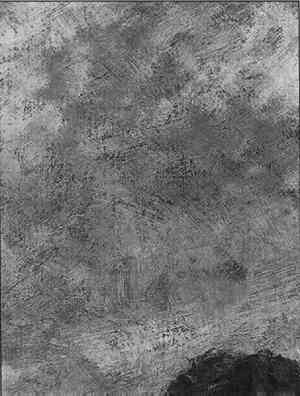INTERPRETING ARTIST'S INTENT IN THE TREATMENT OF JOHN CONSTABLE'S THE WHITE HORSE SKETCHMICHAEL SWICKLIK
5 FOCUSING ON INTENT: FURTHER DISCOVERYAfter viewing the cleaned painting, any doubt about the outcome of the overpaint removal disappears. When considering the treatment options, however, the likelihood of success seemed remote. Only through detailed research on the artist's working methods did the hope emerge that this painting could have been by Constable. At every level of the investigation, whether by art historian or conservator, the knowledge that Constable almost always produced a full-sized sketch for a major finished work pushed the research forward. When Charles Rhyne requested a new set of x-rays for his 1984 study he was looking for evidence of Constable's sketchy style beneath the murky surface. To his surprise he found that the canvas had been reused in such a way that the artist's involvement was virtually guaranteed. The conservator's complex efforts to justify the removal of the overpaint were compelled by the likelihood of finding this sketch. The thickness of the overpaint with its variable solubilities; the multiple layers of both original and nonoriginal paint, each with its own cracquelure; and the somewhat solvent-sensitive original paint combined to make the process less than clear. Ultimately, knowledge of Constable's sketchy style of paint application—with its energetic activity, feathery touch, and characteristic skipping of dry scumbles over the tops of the canvas threads—was the guide. The overpaint removal revealed that Constable had originally planned to execute a sketch for The White Horse on top of his painting of Dedham Vale. However, his reasons for obliterating his initial composition and what he had originally hoped to accomplish in painting it was yet another focus of the investigation. It would be of interest to know whether the Dedham Vale painting had also been a sketch, making it the first of the six foot sketches, or whether, as Rhyne proposed, Constable had executed his first large finished composition on this canvas and abandoned it, presumably because he had not worked the details out in a full-sized sketch beforehand (Rhyne 1990). Rhyne provided some interesting evidence supporting this point of view. He focused primarily on details from the x-radiographs that appeared to show the two buildings in the middleground with a connecting bridge as highly finished elements. However, the version of Willy Lott's house as seen in the x-radiograph seems equally polished; as one of the more finished elements in the now-visible sketch it does not appear at all out of place. Other evidence revealed in the treatment opens the possibility that the same could have been true for the painting underneath. A look at the overall x-radiograph shows that there originally had been a large tree mass in Dedham Vale that rose from lower left to upper right almost to the top of the sky (see A detail of the x-radiograph from the lower left of the painting reveals other relevant information (fig. 9, p. 367). In this area there once was a large, left-leaning tree trunk with a leafy vine climbing it, framing the left foreground of Dedham Vale. Although he painted out the tree trunk in creating the White Horse sketch, Constable left the lower part of the vine to meander about the wooden timbers that lead into The White Horse from the lower left. The vine is painted schematically enough that its inclusion into the sketchy White Horse is not at all out of place.
In sum, the quality of the paint that remains from Constable's first attempt on this canvas seems more like that of his sketchy style than that of his finished style. From the broad nature of this visible work, it is clear that had Constable been attempting a finished version of Dedham Vale, he did not get very far along before he realized that he would need to create full-size sketches for his future large compositions. Just as it is clear from removal of the overpaint that Constable had always intended to create a sketch for The White Horse on this canvas, paradoxically, by revealing the painting, an understanding of his purpose to do so seems even more elusive. Basil Taylor (1973, 38) asked about these large sketches: “Were they rejected solutions abandoned early, full scale modelli, or alternative versions kept in progress with the others in which alternative possibilities could be tested?” Or was the problem, as Kenneth Clark (1946, 14) suggested, “to preserve the vigor and integrity of his studies on a 6 ft. canvas?” Looking at a detail of the paint application from the revealed sketch, it is certainly possible that the latter explanation has an element of accuracy (fig. 10, p. 367). This detail from the area of the sky just above the tree at the right shows paint application that is both energetic and complex. Initially, the paint is applied first in an opaque, liquid form with pink and blue tones blended together. Constable then vigorously brushes into the paint with a dry brush to create strong vertical brushstrokes. Scraping with the end of the brush provides horizontal movement just below. Some dark, feathery applications of blue on top give the feeling of wispy storm clouds. Finally, he swipes across with a wide, well-textured, impastoed stroke in white and bright pink, scraping into it again in a fat vertical stripe to create movement and textural interest. The execution is masterful. One has the sense that Constable is pushing his skill in paint application to its limits. It is undeniable that in this detail, and in much of the rest of the sketch, a passion for the process of painting is evoked. Perhaps Constable found it so unsatisfying to be unable to expose this passion in his entries to the Royal Academy exhibitions that the sketches became the more personally fullfilling part of his process.
The changes in composition that occur from the revealed sketch to the more “finished” Frick painting suggest that Taylor (1973) was |

